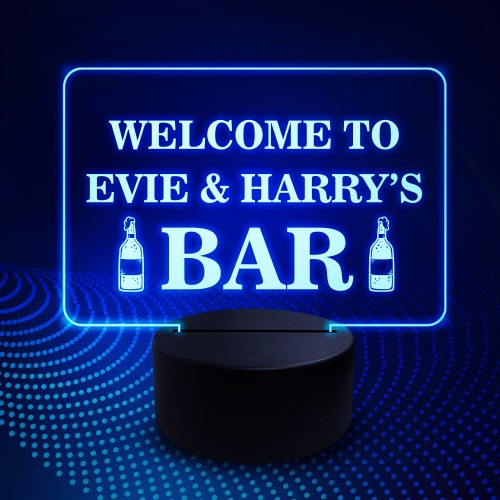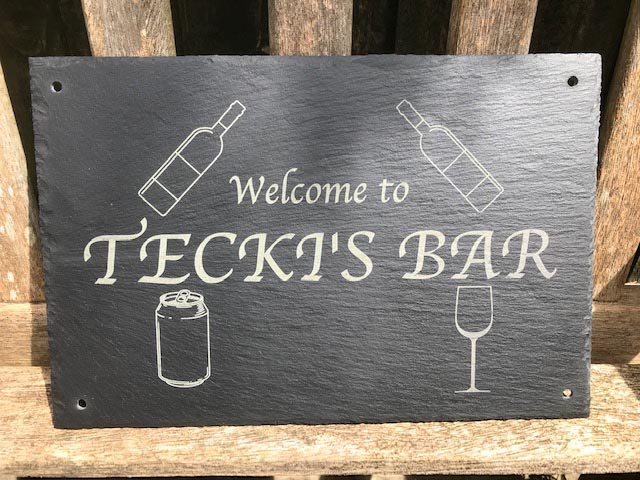Good Suggestions To Picking Bar Signs
Wiki Article
What Are The Differences In Bar Sign Sizes?
Bar signs differ in size depending on their intended purpose, placement and overall aesthetic. Here's a look at how the size of bar signs affects their function and aesthetic appeal. Large Signs
The purpose is to act as a focal point to draw the attention of.
Uses for: Exterior branding, primary brand signs, or feature wall.
The place is usually above entrances, on large walls, or in front of the bar area to attract patrons.
Examples include large neon signs in vintage style and large-sized murals and oversized vintage signs.
2. Medium Signs
The main purpose behind wall art is to offer details and improve decor without occupying space.
The uses include menu boards, as well as directions and displays for promotions.
Placement: Positioned so that it is easily visible but not overpowering.
Examples: Medium-sized chalkboards to advertise daily specials, metal signs bearing the logo of the bar, or themed decorative signs.
3. Small Signs
Purpose: To offer specific information or to add subtle ornamental elements.
Uses: Table signs or small ornaments.
Tables and displays should be placed in a way which are near to the viewer.
Examples include table number signs, small-framed quotes, or drinks menu cards.
Size Factors
Visibility
Large Signs: Made to be visible from a distance, making them ideal for attracting passersby and establishing the bar's reputation.
Medium Signs: They balance the need for information while maximizing space. They provide it without overwhelming decor.
Small Signs: Ideal for intimate information or close-up details. Helps enhance the customer's experience by placing them at eye level.
Proportion
To prevent overwhelming smaller areas the large sign should be proportional to the size of the area. A great choice for big or open areas.
Medium Signs - Works nicely with all interiors and can be used for a variety of positioning.
Small signs are great to add detail and fit in tighter spaces.
Impact
Large-sized signs makes a bold and imposing statement. This is an important aspect of branding. Bar signs are used to establish a particular tone.
Medium signs are a great mix of the appearance and the visibility. They contribute to a pleasant atmosphere, while also conveying important messages.
Small signs: add the look and feel of a sign which create a better visual experience.
Practicality
Due to the dimensions, large signs can cost a lot.
Medium Signs: Easy to install, reposition and are flexible with design changes.
Small Signs are easy to update and replace These signs are great for environments that are dynamic, like bars, where promotions or menus change frequently.
Functionality
Large Signs: primarily used to draw attention and increase visibility.
Medium Signs: They are functional as well as decorative. They are a source of vital information, but also enhance the aesthetics.
Small signs: These are usually functional and provide specific information. They can be used to enhance the overall theme of the space in a subtle manner.
The size of bar signage is determined by their function their layout, as well as the their impact on customers. Balance these elements to ensure the signs are contributing effectively to the overall atmosphere of the bar and the operational requirements of the bar. See the top agree with about garden bar signs for blog recommendations including hanging bar sign, personalised home bar signs, sign for garden bar, personalised pub signs for garden, outdoor home bar signs, pub signs for garden, to the bar sign, design your own bar sign, pub signs made, pub signs to buy and more.

What Is The Main Difference Between Bar Signposts And Other Signage Regarding Light?
Bar signs differ significantly in regards to lighting, which affects their ambiance, visibility, as well as their overall impression. Here are some of the important ways that lighting affects bar signs. Neon Signs
Characteristics: Bright, colorful, classic.
Lighting: Uses gas tubes filled with neon that emit illumination when they are electrically charged.
Uses : Great for creating an old-fashioned, retro style. Used for logos and bar names.
The nostalgic appeal as well as the high visibility make this a great choice.
The material is delicate and can be costly to fix.
2. LED Signs
Characteristics: Energy-efficient, versatile, modern.
Lighting LEDs: Light-emitting Diodes (LEDs) that produce a bright, vibrant and bright light.
Uses: It is suitable for outdoor or indoor signs, as well as display that can be programmed.
Benefits: LEDs are long-lasting, efficient in energy use, and are programmable with animated or color changes.
Negatives: Could be expensive initially, but it can also help you save money on maintenance and energy costs.
3. Signs with Backlights
Characteristics: Elegant, sophisticated, subtle.
Lighting Lights: LEDs or fluorescent lights behind a transparent surface creates an soft glow.
Uses: Typically for bar menu boards, signs, as well as branding components.
Advantages: A professional and clean appearance is offered, which improves readability even in low lighting.
The installation is more complex and the upfront cost is more expensive.
4. Signs with Edge-Lit
Characteristics: Sleek, contemporary, stylish.
Lighting Utilize LEDs to light the edge of a sign typically made of acrylic.
It is a good choice for modern design, minimalist.
Features: Gives sophisticated, distinctive looks. It is energy efficient.
Advantages: Only available in certain style of design.
5. Ambient/Accent Lighting
Characteristics: Subtle, atmospheric, decorative.
Lighting: Make use of indirect lighting sources to emphasize or highlight signs.
Uses: Increases the ambience and is commonly employed to highlight artwork or theme-related decor.
Benefits: Creates an atmosphere and depth to create a cozy and inviting atmosphere.
Advantages
6. Marquee Signs
Characteristics: Bold, theatrical, eye-catching.
Lighting: Brighten the sign with multiple bulbs or LEDs.
Signs for exterior use for event promotions, as well as retro-style cinemas are very popular.
The design is prominent and attracts people's attention.
Some disadvantages include high costs and regular maintenance.
7. Projection Signs
Characteristics: Dynamic, innovative, versatile.
Lighting: Projects light and images using projectors on flat surfaces.
Uses : Great for promotions that are temporary, special events, and for dynamic displays.
Advantages: Easy to change and there is no structure is needed.
Disadvantages
8. Fluorescent Signs
Characteristics: Bright, cost-effective, traditional.
Lighting: Utilizes fluorescent tubes to provide illumination.
Uses: Typically used on larger outdoor and indoor signs.
Benefits: Effective and bright for large signs. Costs are relatively low.
Advantages
Lighting Considerations
Visibility
Neon LEDs and neon signs can be extremely effective in grabbing people's attention, especially in low-light situations.
Signs that are backlit or edge lit are great for improving visibility and creating the appearance of polished.
Energy Efficiency
LED Signs are energy-efficient. They also last for a long time.
Neon and fluorescent signs aren't as energy efficient and neon signs are more fragile.
Aesthetic Appeal
Neon and Marquee signs are ideal for retro or vintage aesthetics.
Backlit and edge-lit Signs: Ideal for contemporary, modern designs.
Ambient lighting: It improves the ambience and overall mood.
Maintenance
LED Signs: Durable and low-maintenance.
Neon and Fluorescent Signs require frequent maintenance as well as potential repairs.
Cost
LED Backlit Signs: Expensive initial costs, but lower operating costs.
Fluorescent signs have lower initial costs, but higher costs for energy over the long term.
Flexibility
Projection LED Signs as well as LED Signs that can be programmed Offer flexibility and high dynamic content for display.
Traditional Signs: They're less flexible, but they typically achieve a specific appearance.
The appropriate lighting can create the right atmosphere and to effectively communicate with patrons. Have a look at the best view website for website info including signs for the bar, signs for garden bar, pub signs for home bars, bespoke bar signs, a bar sign, the staying inn sign, personalised pub signs for sale, staying inn sign, personalised signs for bar, pub signs for home bars and more.

What Are The Distinctions In Bar Signs That Relate To Interactivity?
Bar signs may incorporate different levels of interaction to entice patrons and enhance the overall experience for customers. The interactivity of bar signs can be distinct. Static Signs
Traditional Design: static signage conveys information, but without interactivity.
Common Types: Printed posters, painted murals or traditional neon signs.
2. Digital Displays
Dynamic Content Digital signage allows for real-time updates, animations as well as multimedia content.
Interactivity: Touchscreen displays may provide interactive games menus, interactive games, or other promotional content.
Benefits include: Draw attention to dynamic information while encouraging patron engagement.
3. QR Codes
QR Codes are able to link directly to social media profiles or menus.
Benefits: Easy access to additional information and promotions or loyalty programs.
4. LED Screens
Dynamic messaging: LED screens show scrolling text, animations, or video clips.
Interactivity: Touch-enabled LED screens enable patrons to interact with the screen, such as by selecting menu items or playing games.
Benefits Include: Grab attention through creating experiences that are immersive.
5. Projection Mapping
Immersive Experiences: Projection mapping transforms surfaces into dynamic displays, offering interactive storytelling and interactive visuals.
Customers can play interactive games, or experiencing virtual experiences.
Benefits include: the creation of an atmosphere that encourages social interaction and improves the experience of being in the room.
6. Augmented Reality (AR).
AR: AR overlays interactive digital content onto the physical world.
AR enabled signs allow customers to interact virtual elements like recipes for cocktails or virtual games.
Benefits: Set your bar apart from others by offering distinctive experiences and enthralling patrons.
7. Motion Sensors
Motion sensors can detect motion and trigger interactive responses on signs.
Interactivity: Signs that respond to the patron's movement may display animations, alter content, or display specific messages.
Benefits: Enhance engagement, create immersive environments, and amaze and delight customers.
8. Social Media Integration
Internet Interaction: Posters with hashtags or social media handles can encourage patrons online interaction.
User-generated Materials: Inspire your customers to upload photos of signs on social networks which will increase the exposure and popularity of your bar.
Benefits : Increase the involvement of communities, boost the visibility of brands, and generate content that is created by users.
9. Interactive Lighting
Dynamic Effects Neon or LED Signs that have Interactive Lighting can Respond to Sound, Touch, or Motion.
Signs are interactive and can change changing the color, brightness or even pattern depending on the interaction of patrons or environmental cues.
Benefits: Improve ambience and create immersive environments.
10. Gamification
Interactive Games: Signs that include interactive games and challenges that keep customers entertained and encourage participation.
You can give discounts or incentives for completing games or challenges.
Benefits : Increase dwell time. Facilitate social interaction. Promote repeat visits.
Bar owners can design exciting experiences by incorporating interactive elements into their signs. This can entice customers, increase brand awareness and help them differentiate themselves from the competition. Have a look at the top rated hanging pub signs url for blog tips including personalised outdoor bar signs, pub bar signs for sale, hanging pub signs, hanging pub signs personalised, outdoor home bar signs, personalised hanging bar sign, hanging pub signs for garden, pub bar signs for sale, personalised pub, the staying inn bar sign and more.
